by Adam Willwerth, Development Manager, Electro Static Technology, Mechanic Falls, Maine
With the rising cost of energy, more variable-frequency drives (VFDs) are being installed for motion and speed control. They are highly efficient, but the currents they induce on motor shafts can wreak havoc with bearings, which dramatically shorten motor life and reduce system reliability. To mitigate these currents and realize the full potential of VFDs, a cost-effective method of shaft grounding is essential.
Define potential problems
In a typical VFD, a thyristor or diode converts the ac input to direct current (dc). A filter smoothes the current’s waveform, and a pulse-width modulation (PWM) inverter converts it to variable ac with insulated-gate, bipolar transistors (IGBTs). The typical output switching frequency is 2 to 12 kHz. VFDs may directly drive one or more motors in constant-torque applications to ensure that they do not use more power than necessary. With encoder feedback, a VFD can also control the speed of a motor by modulating the motor’s voltage and frequency according to programmed parameters.
The VFD waveform contains high-frequency components that are capacitively coupled to the motor shaft and discharge through the bearings. They are non-sinusoidal and contain high-frequency currents and voltages called harmonics. And even when the motor is designed for inverters, it is vulnerable to bearing failure from VFD-induced currents.
Without some form of mitigation, these shaft currents or eddy currents discharge to ground through bearings, causing pitting, fusion craters, and “fluting.” This leads to excessive bearing noise, premature bearing failure, and subsequent motor failure.
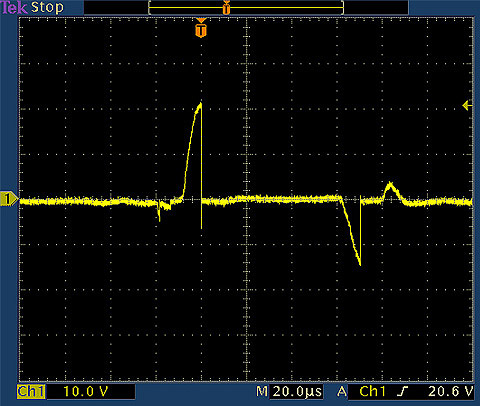
Induced shaft currents show up as common-mode voltages when measured with an oscilloscope probe touching the shaft.
Motors are never fully compatible with the VFDs that drive them unless these shaft currents are substantially reduced or eliminated. Obviously, the significant cost savings that VFDs deliver in so many applications will be lost if a motor fails because its bearings go bad. And there is considerable evidence to prove that VFD-induced bearing damage is a large and growing problem. Consider this:
• Most motor bearings last for 100,000 hours, yet motors controlled by VFDs can fail within one month (720 hours).
• An HVAC contractor recently reported that all of the VFD-controlled 30 to 60 hp vane-axial fan motors he installed in a large building project failed within a year (two within 6 months). Repair costs totaled more than $110,000.
• Several large pulp and paper companies surveyed noted that the VFD-controlled ac motors used in their plants typically fail due to bearing damage within six months.
• The largest motor manufacturer in the United States has cited eliminating drive-related motor failures as its number-one engineering challenge.
Various other negative effects can also appear when the driven motor is not designed for a VFD or if either the motor or the VFD is not rated properly for the application or the load. For example, when required to maintain a constant torque, a motor tends to lose some efficiency and runs hotter at lower speeds, but hotter yet when VFD-controlled. If such a motor must be operated at less than 30% of its maximum speed, it may need additional cooling or thermal protection. Similarly, a VFD-controlled motor’s capability to produce torque drops more quickly at lower motor speeds than a motor using pure sine-wave power. For constant-torque loads, a VFD should be rated for 60 s at 150% of the load. A VFD’s current rating also limits the load-acceleration rate.
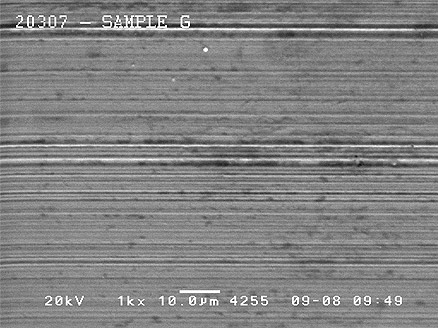
Viewed under a scanning electron microscope, a new bearing race wall appears as a relatively smooth surface. However, in VFD-driven motors, tracks eventually form where ball bearings contact the wall. With no electrical discharge, the wall is marked by nothing but this mechanical wear. Without proper grounding, VFD-induced electrical discharges can quickly scar the race wall.
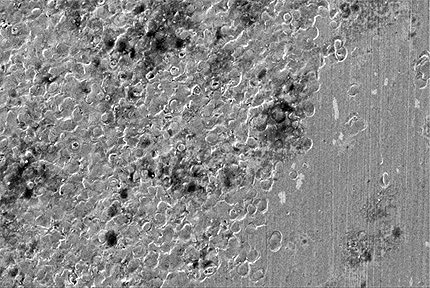
Frequent discharges riddle the bearing race with pits, which are commonly called frosting. During virtually every VFD cycle, the induced currents discharge from the motor shaft to the frame via the bearings and produce small fusion craters in ball bearings and the bearing race wall. The damage eventually leads to noisy bearings, but by the time such noise is noticeable, bearing failure is often imminent.
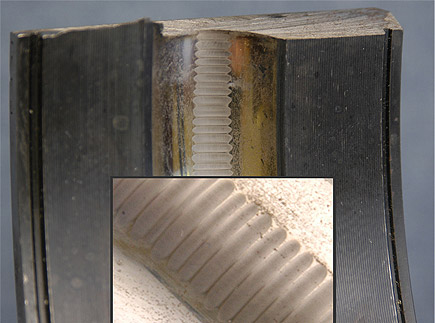
The amount of fluting produced comes from the operational frequency of the VFD. This causes pitting that concentrates along the bearing race wall and forms washboard-like ridges. Fluting can cause excessive noise and vibration. In an HVAC system, the noise may be magnified and transmitted throughout the entire building via ductwork.
Another rule of thumb is that the cable connecting a VFD with a motor should not be more than 50-ft long, or two different wave types could meet at the motor terminals and effectively double the voltage at the motor. If a longer cable is required, rigid conduit and additional line filtering can protect the motor and other sensitive equipment nearby from harmonics and radio frequency interference (RFI). Regardless of its length, the cable between a VFD and the motor or motors it regulates can be enclosed in a corrugated aluminum sheath or another kind of grounded, low-impedance shielding.
Bearing damage
Every VFD-controlled ac motor develops a parasitic capacitance between the stator and rotor. Short of dismantling the motor, check for bearing damage from induced shaft currents by measuring vibration and voltage. Both require special equipment and experienced personnel to conduct tests and analyze the results. Both are best used to establish a preliminary baseline, so that trends can be monitored later.
When vibration tests confirm bearing damage by identifying particular energy spikes in the range of 2 to 4 kHz, the damage has usually reached the “fluting” stage. A high carrier frequency means a high discharge rate, so purchase a VFD that permits fine-tuning of the carrier frequency in increments no larger than 1 kHz. In general, keep the frequency as low as possible, and no higher than 6 kHz.
Likewise, the main benefit of voltage tests may be the relief they provide when the results indicate no bearing damage. If a baseline voltage measurement is taken right after a VFD has been installed, successive tests may provide early warning of harmful current loops, but there are many variables. Predicting bearing damage is not an exact science.
Voltages measured with an oscilloscope probe can be seen to repeatedly build up on the rotor to a certain threshold, then discharge in short bursts along the path of least resistance, which often runs through the motor’s bearings to the frame (ground). Serious bearing damage is probably more likely in systems that operate with high carrier frequencies, a constant speed, or inadequate grounding.
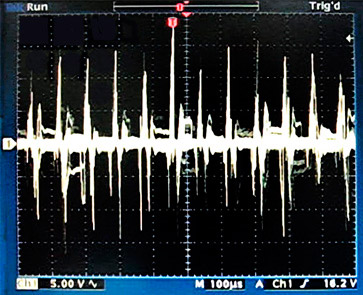
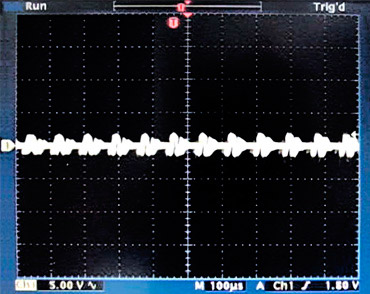
Without some form of mitigation, VFD-induced shaft currents (shown on top oscilloscope screen) can cause considerable motor-bearing damage. The screen on the bottom demonstrates how effectively the AEGIS SGR™ reduces these currents and the damage they cause by channeling them safely to ground. Its patent-pending Electron Transport Technology™ uses the principles of ionization to boost the electron-transfer rate and promote extremely efficient discharge of the high-frequency shaft currents.
Reducing bearing damage
Electrical damage to ac motor bearings often begin at startup, grows progressively worse over time, and then the bearings eventually fail. To prevent this, the induced current must be diverted from the bearings with insulation, shielding, or a path to ground. These methods vary in cost and effectiveness.
Insulating motor bearings is a partial solution that more often than not shifts the problem elsewhere. Blocked by insulation, shaft current seeks another path to ground. Attached equipment, such as a pump, often provides this path, and frequently winds up with bearing damage of its own. In addition, insulation is relatively expensive and subject to contamination. Worse yet, some types of insulation can be totally self-defeating: In certain circumstances, the insulating layer has a capacitive effect on high-frequency VFD-induced currents and lets them pass onto the bearings it was supposed to protect.
In addition to insulation, consider these possible solutions:
• A Faraday shield can be made with grounded conductive material such as copper foil or paint between the stator and rotor. This can block most of the harmful currents that jump across the motor’s air gap, but it is often expensive and difficult to implement, and attached equipment could still be vulnerable to deflected currents.
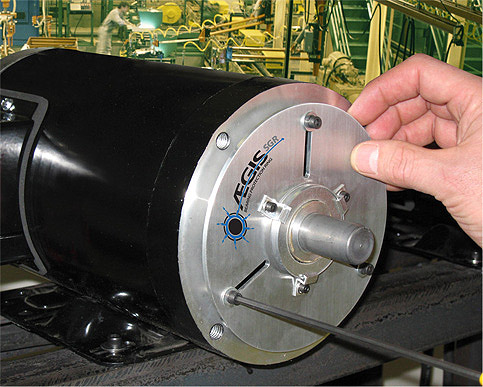
This is an
AEGIS SGR with NEMA adaptor plate. Electro Static Technology
guarantees that any new motor (up to 100HP/75kw) on which the SGR is
properly installed will not fail from electrical fluting damage to
bearings.
• Nonconductive ceramic ball bearings divert currents from the main motor’s bearings but also leave attached equipment open to damage of its own. Ceramic bearings can be costly and usually must be resized to handle mechanical static and dynamic loads.
• Conductive grease in the bearings can bleed off currents through this lower-impedance. In practice, however, the conductive particles in the grease increase mechanical wear.
• Metal grounding brushes contact the motor shaft to provide alternative paths to ground, but they wear, corrode, and require regular maintenance.
• Alternative discharge paths to ground are preferable to insulation because they neutralize shaft current. These techniques range in cost and sometimes can only be applied selectively, depending on motor size or application. The ideal solution would provide an effective, low-cost, very-low-resistance path from shaft to frame and could be broadly applied across all VFD/ac motor applications. This affords the greatest degree of bearing protection and maximum return on investment.
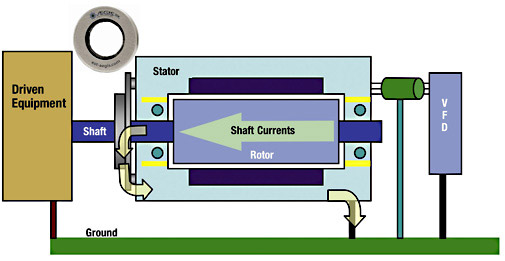
When installing a single SGR on a small motor, the motor’s drive end is the preferred location. The AEGIS SGR comes in two versions — a continuous ring for most NEMA- and IEC-frame motors and a split-ring design which allows installation in the field, around larger shafts, without the need to disassemble attached equipment. A mounting adaptor included with every NEMA or IEC model SGR facilitates installation of the device on motors with shaft shoulders, slingers, bearing caps, or end-bell protrusions. In critical applications where motors with two ceramic bearings are specified, at least one SGR should be used to ensure that shaft voltage does not pass down the line to attached equipment such as gearboxes, pumps, encoders, pillow-block bearings, or break motors.
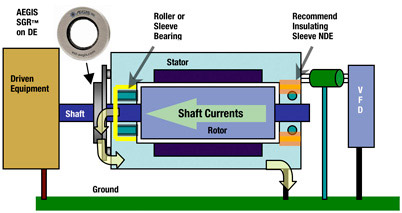
For most larger motors, the best bearing protection may be obtained by installing an SGR on the drive end of the shaft and insulation on the non-drive end.
All the above approaches work to some degree, but the most effective solution comes from Electro Static Technology’s AEGIS SGR Bearing Protection Ring™, designed with special conductive microfibers. The ring redirects shaft currents and provides a reliable, very-low-impedance path from shaft to frame, which bypasses the motor bearings entirely.
The AEGIS SGR is scalable to any NEMA or IEC motor regardless of shaft size, horsepower, or application. They are on power generators, gas turbines, ac traction and break motors, clean-room motors, HVAC systems, and other industrial and commercial applications.
For VFD-equipped motors of less than 100 hp (75 kW) with shaft diameters of less than 2 in. (50mm), a single SGR on the drive end of the motor shaft is typically sufficient to divert shaft currents. Large ac motors (100hp/75kW or more) and even large dc motors, especially those with shaft diameters of more than 2 in., are more likely to have high-frequency circulating currents and discharges that can damage bearings. Motors with roller bearings are also more vulnerable to the circulating currents because they have a greater surface area and their lubricant layer is usually thinner. Such motors benefit from the combination of an SGR on the drive end and insulation on the non-drive end to break the circulating current path. This may also work where installing an SGR on the non-drive end would be impractical because of encoders, fans, or other features.
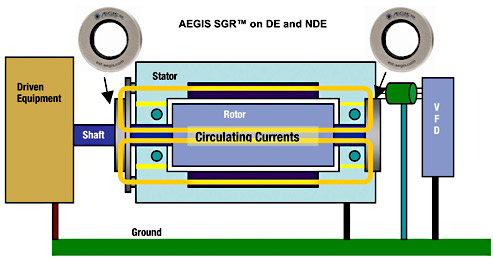
Two SGRs are recommended for some larger motors.
An SGR is also a common solution for motors above 500hp (375kW), and most manufacturers already take this approach. However, when insulation on the drive end is not designed into the motor or cannot be easily installed, two SGRs are recommended — one on the drive end (DE) and one on the non-drive end (NDE).
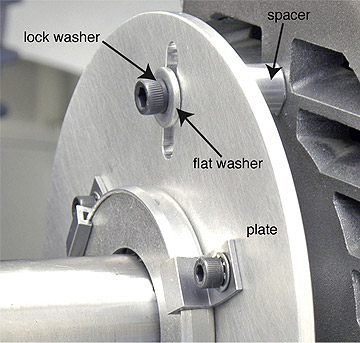
Close-up of an SGR installed with mounting plate and standoff posts (spacers).
Once installed, the SGR requires no maintenance. Unlike conventional shaft grounding brushes, its conductive microfibers work with virtually no friction or wear. They are unaffected by dirt, grease, or other contaminants, and last for the life of the motor, regardless of motor speed. Test results show surface wear of less than 0.001 in. per 10,000 hr of continuous operation, and no fiber breakage after 25 million
direction reversals.
Electro Static Technology
www.est-static.com
::Design World::


Leave a Reply
You must be logged in to post a comment.